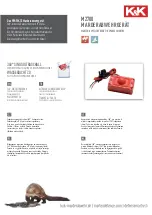
5
Instructional Leaflet
IB48041
Effective December 2009
Instructions for AMPGARD 400A
medium voltage starter
eaton corporatIon
www.eaton.com
Figure 8. Handle Mechanism with Contactor and Door Interlocks
Mechanical and electrical interlocks are provided to ensure that the
non-loadbreak isolation switch cannot be opened or closed unless
the main contactor is de-energized. (See contactor interlock rod in
Figure 8.
) Do not attempt to force the switch-operating mechanism
with the main contactor closed. The handle mechanism is designed
to fail before the isolation switch can be opened with the main
contactor closed.
caution
applying excessive force to the switch hanDle with the
mechanical interlocks engageD will result in Damage to
the switch.
An electrical interlock is provided to disconnect the control power
transformer secondary before the isolating switch stabs are
disconnected from the controller line fingers. This interlock ensures
that the switch is breaking transformer magnetizing current only.
Do not connect additional loads to the controller isolating switch.
Danger
if loaDs greater than the interrupting rating of the switch
are connecteD to the switch, equipment Damage, personal
injury, or Death may occur.
An optional key interlock may be provided to lock the switch in the
open position for special configurations. Refer to the specific order
drawings to determine if key interlocks have been provided.
On reversing, two-speed, or autotransformer type starters,
mechanical interlocks are provided to prevent two or more
contactors from closing at the same time.
Low voltage control
The low voltage control compartment is located in a steel pocket in
the medium voltage door. A low voltage door with up to four device
panels provides access to the low voltage compartment with the
medium voltage door closed. The low voltage compartment swings
out of the way with the medium voltage door as it is opened,
allowing access to the isolation switch, fuses, main contactor,
and other starter components that are mounted behind the low
voltage compartment.
A row of control terminal blocks is provided on the left side of the
controller. They can be accessed by opening the low voltage door.
The blocks are fixed mounted and remain in place when the medium
voltage door is opened. Refer to
Figures 9
and
10
for details.
Figure 9. Low Voltage Terminal Blocks, Medium Voltage
Door open
Figure 10. Low Voltage Terminal Blocks, Low Voltage
Door open
A test plug and receptacle are typically supplied inside the low
voltage section. The receptacle is wired to the secondary of the
controller control power transformer. Test power can be used to
energize the control circuit by removing the plug from the receptacle
and using a standard extension cord to energize the plug. Refer to
Figure 11
for specific location.
Figure 11. Low Voltage Compartment with Test Plug
Danger
Do not connect test power to the starter control circuit
without removing the plug from the receptacle. failure to Do
so will result in a back-feeD conDition on the control power
transformer, which will generate high voltage insiDe the
controller with the isolation Device open. high voltage can
cause severe injury or Death.
Isolation
Switch
Drive Rod
Contactor
Interlock
Rod
MV Door
Interlock
Plunger
MV Door
Hold-Down
Interlock
Test Plug






























